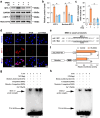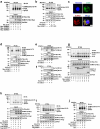SENP1 mediates zinc-induced ZnT6 deSUMOylation at Lys-409 involved in the regulation of zinc metabolism in Golgi apparatus
- PMID: 39367979
- PMCID: PMC11455790
- DOI: 10.1007/s00018-024-05452-4
SENP1 mediates zinc-induced ZnT6 deSUMOylation at Lys-409 involved in the regulation of zinc metabolism in Golgi apparatus
Abstract
Zinc (Zn) transporters contribute to the maintenance of intracellular Zn homeostasis in vertebrate, whose activity and function are modulated by post-translational modification. However, the function of small ubiquitin-like modifier (SUMOylation) in Zn metabolism remains elusive. Here, compared with low Zn group, a high-Zn diet significantly increases hepatic Zn content and upregulates the expression of metal-response element-binding transcription factor-1 (MTF-1), Zn transporter 6 (ZnT6) and deSUMOylation enzymes (SENP1, SENP2, and SENP6), but inhibits the expression of SUMO proteins and the E1, E2, and E3 enzymes. Mechanistically, Zn triggers the activation of the MTF-1/SENP1 pathway, resulting in the reduction of ZnT6 SUMOylation at Lys 409 by small ubiquitin-like modifier 1 (SUMO1), and promoting the deSUMOylation process mediated by SENP1. SUMOylation modification of ZnT6 has no influence on its localization but reduces its protein stability. Importantly, deSUMOylation of ZnT6 is crucial for controlling Zn export from the cytosols into the Golgi apparatus. In conclusion, for the first time, we elucidate a novel mechanism by which SUMO1-catalyzed SUMOylation and SENP1-mediated deSUMOylation of ZnT6 orchestrate the regulation of Zn metabolism within the Golgi apparatus.
Keywords: MTF-1; SENP1; SUMOylation; Zinc; Zinc transporter; Zn homeostasis.
© 2024. The Author(s).
Conflict of interest statement
All the authors disclosed no conflict of interest.
Figures









Similar articles
-
SENP1 Senses Oxidative Stress to Regulate the SUMOylation Modification of ZIP8 and Maintain Zinc Transport Functions.Antioxidants (Basel). 2025 Jun 18;14(6):750. doi: 10.3390/antiox14060750. Antioxidants (Basel). 2025. PMID: 40563382 Free PMC article.
-
SUMO protease SENP1 deSUMOylates and stabilizes c-Myc.Proc Natl Acad Sci U S A. 2018 Oct 23;115(43):10983-10988. doi: 10.1073/pnas.1802932115. Epub 2018 Oct 10. Proc Natl Acad Sci U S A. 2018. PMID: 30305424 Free PMC article.
-
The SUMO-specific protease SENP1 deSUMOylates p53 and regulates its activity.J Cell Biochem. 2021 Feb;122(2):189-197. doi: 10.1002/jcb.29838. Epub 2020 Aug 12. J Cell Biochem. 2021. PMID: 32786121 Free PMC article.
-
SUMOylation and De-SUMOylation: wrestling with life's processes.J Biol Chem. 2009 Mar 27;284(13):8223-7. doi: 10.1074/jbc.R800050200. Epub 2008 Nov 13. J Biol Chem. 2009. PMID: 19008217 Free PMC article. Review.
-
Regulation of post-translational modification in breast cancer treatment.BMB Rep. 2019 Feb;52(2):113-118. doi: 10.5483/BMBRep.2019.52.2.017. BMB Rep. 2019. PMID: 30638182 Free PMC article. Review.
Cited by
-
SENP1 Senses Oxidative Stress to Regulate the SUMOylation Modification of ZIP8 and Maintain Zinc Transport Functions.Antioxidants (Basel). 2025 Jun 18;14(6):750. doi: 10.3390/antiox14060750. Antioxidants (Basel). 2025. PMID: 40563382 Free PMC article.
References
-
- Wei CC, Luo Z, Hogstrand C, Xu YH, Wu LX, Chen GH et al (2018) Zinc reduces hepatic lipid deposition and activates lipophagy via Zn2+/MTF-1/PPARα and Ca2+/CaMKKβ/AMPK pathways. FASEB J 32:6666–6680 - PubMed
-
- Wu K, Luo Z, Hogstrand C, Chen GH, Wei CC, Li DD et al (2018) Zn stimulates the phospholipids biosynthesis via the pathways of oxidative and endoplasmic reticulum stress in the intestine of freshwater teleost yellow catfish. Environ Sci Technol 52(16):9206–9214 - PubMed
-
- Xu YC, Zheng H, Hogstrand C, Tan XY, Zhao T, Song YF et al (2023) Novel mechanism for zinc inducing hepatic lipolysis via the HDAC3-mediated deacetylation of β-catenin at lysine 311. J Nutr Biochem 121:109429 - PubMed
-
- Ibs KH, Rink L (2003) Zinc-altered immune function. J Nutr 133:1452S–6S - PubMed
-
- Foster M, Samman S (2010) Zinc and redox signaling: perturbations associated with cardiovascular disease and diabetes mellitus. Antioxid Redox Signal 13(10):1549–1573 - PubMed
MeSH terms
Substances
Grants and funding
LinkOut - more resources
Full Text Sources
Research Materials
Miscellaneous

